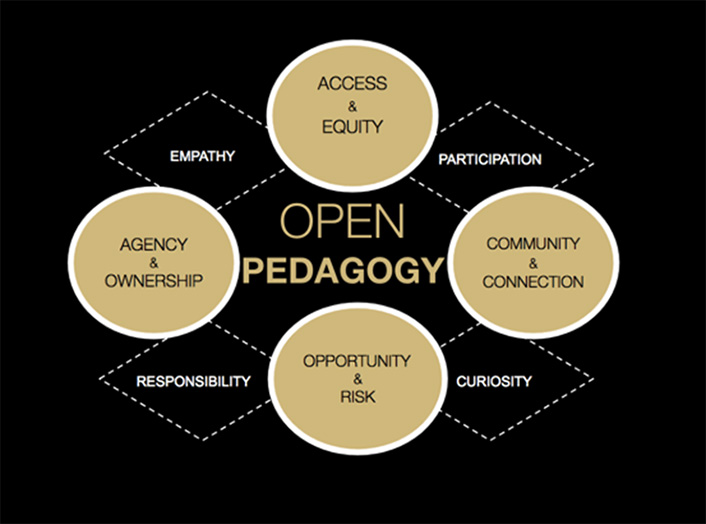To support open educational practices, we must understand the meaning of open pedagogy and articulate the values that shape it.

This post is the second of three blogs authored by Amanda McAndrew, Caroline Sinkinson, and Deborah Keyek-Franssen of the University of Colorado. Together, these blogs explore the intersections of inclusive and open practices to inspire conversation about how we might use these pedagogies to enhance learning opportunities and experiences at our institutions.
Amanda, Deborah, and I have been inspired by educators who have adopted open pedagogical practices and serve as exemplars. To name a few:
- Robin de Rosa's projects to invite student-generated textbooks
- Mike Caulfield's call to students to help improve coverage of local news sources on Wikipedia's Newspapers on Wikipedia Project
- Rajiv Jhangiani's initiative to facilitate a student-composed test bank
- Danica Savonick's encouragement of a student co-authored journal submission
There are so many others we might reference, many of which are described on the Open Pedagogy Network, where contributors are encouraged to share "ideas for implementing or experimenting with open pedagogy." In the "What is Open Pedagogy" section, Robin DeRosa and Rajiv Jhangiani resist defining open pedagogy and encourage contributors to understand that the concept is continually changing shape and under negotiation. For these authors, open pedagogy is "a site of praxis, a place where theories about learning, teaching, technology, and social justice enter into a conversation with each other and inform the development of educational practices and structures." They encourage consideration of hopes and aspirations for education rather than seeking a solidified definition.
We began with DeRosa and Jhangiani's call and considered the aspirations that we hold for our open educational practices and learning environments. If we named them, could we use them as a framework to check that our practices matched our intentions? This was particularly important to us because while we are inspired by the opportunity to give voice to students in authentic ways and to engage them in shared and participatory knowledge creation, we also acknowledge the risk inherent in working in the open. As Catherine Cronin notes, we must be attentive to "the potential for openness to do the opposite of what we intend and to create or exacerbate inequalities."
So we sought to clearly articulate our goals and values. First, we identified four primary habits that we hope our practice embodies and inspires in students: responsibility, curiosity, empathy, and participation. We seek to take responsibility for our choices to work in the open and to reflect on the impact of those choices for ourselves and others. Similarly, we hope to carefully weigh how we wish to participate openly and how that participation may impact others. In all of our work with open pedagogy, we seek to inspire curiosity, empathy, and cultural humility as we encounter and enter into dialogue with varied identities, perspectives, cultures, and ways of being.
Next, we named the aspects of open pedagogy that most strongly resonate with us and our teaching values (see figure 1).

Access and Equity
Commitment to reducing barriers that prevent equitable access to education, including economic, technical, social, cultural, and political factors. (see Maha Bali and Christina Hendricks)
Community and Connection
Commitment to facilitating connections across the boundaries of learning experiences, classrooms, campuses, countries, communities, and viewpoints. This might include inviting authentic student collaboration with peers, experts, and the public. (see Robin DeRosa and Bronwyn Hegarty)
Agency and Ownership
Commitment to protecting agency and ownership of one's own learning experiences, choices of expression, and degrees of participation. (see Rosen and Smale)
Risk and Responsibility
Commitment to interrogate tools and practices that mediate learning, knowledge building, and sharing and to resist the treatment of open as neutral. (see Jesse Stommel and Audrey Watters)
These are our initial attempts to name the central values of open pedagogy, to which we aspire. As DeRosa and Jhangiani stated, open pedagogy is a site of praxis and a concept defined by ongoing conversation. As you consider open pedagogy, what value and aspirations arise for you?
Caroline Sinkinson is Associate Professor and Head of Teaching and Learning in the University of Colorado in Boulder's University Libraries.
© 2018 Caroline Sinkinson. The text of this work is licensed under a Creative Commons BY-SA 4.0 International License.
